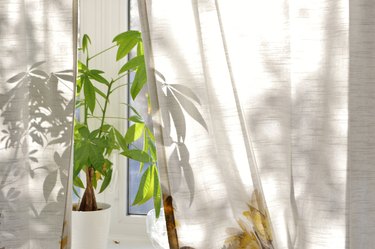
When grown outdoors, gardeners prize the money tree (Pachira aquatica) for its showy, fragrant flowers and tasty, peanut-like fruits. Many people also grow money trees indoors. Although they typically don't bloom inside, as their natural habitat is in U.S. Department of Agriculture plant hardiness zones 10 through 12, feng shui teaches that money trees bring prosperity and good fortune to those who keep them as houseplants. Like all plants, you'll have to repot a money tree when it outgrows its flowerpot.
Basic Money Tree Care
Video of the Day
In its native tropical swamp habitat, a money tree can easily reach heights of 60 feet. When grown outside of its hot and humid wetlands, it won't get that tall but can still grow to 30 feet, so choose a planting location with plenty of headroom. If potting your plant, expect it to stay a more manageable 8 feet high.
Video of the Day
Keep the soil for your money tree moist to wet. If the soil is too dry, your plant will let you know by dropping its leaves. Money trees will tolerate some shade but do best when given copious amounts of sunlight.
Plants grown in a container need repotting when their roots poke out of the bottom of the container. Other signs that it's time for a new pot are slow growth and unusually rapid water usage.
Prepare for the Move
Repot the money tree in spring or summer, when it's actively growing. Water it well, then let it drain for an hour while you prepare its new container, and cover the work area with newspapers.
Choose a pot 1 or 2 inches larger in diameter than the current one, with at least one drainage hole in its base. To prevent potting soil from washing out of the pot when you water, cover the drainage hole with a coffee filter or fine-mesh screen.
Mix the Potting Soil
Repot a money tree with fresh potting mix formulated for moisture-loving plants. A soilless mix containing peat, pine bark and vermiculite or perlite works well. Homemade potting mix is less expensive than commercial brands. To make your own, mix equal parts peat moss, vermiculite and coarse (or builder's) sand.
Remove the Tree
If the money tree is small, place the thumb and forefinger of one hand around the base of its trunk and with your open palm resting on top of the soil. Lift and invert the pot with the other hand so the tree slides out.
Don't pull on the delicate trunk if the tree resists. Instead, bang the base of the pot lightly against the work surface to loosen the rootball until it slides out easily. Get help, if necessary, to lift a large money tree onto the work surface, and place the pot on its side before sliding the tree free.
Examine the rootball for tangled, encircling roots or mushy, dark roots. Tease the tangled ones apart with your fingers and cut away encircling or mushy ones with a clean, sharp knife. Wipe the knife blade down with a clean rag dipped in rubbing alcohol between cuts so it doesn't spread disease.
Repot the Money Tree
Pour enough potting mix into the new container so the top of the rootball is 1 inch below the rim. Center the tree on top of the mix and gradually fill in around it, tamping lightly with your fingers to eliminate air pockets.
When the potting mix reaches the top of the rootball, water the tree until liquid drains from the drainage holes. A mix containing peat may need watering several times before it's completely moist. If the potting mix settles more than 1/2 inch below the rim, add enough to cover the root ball while leaving 1/2 inch of space for future watering.
Move the tree to a cool spot out of direct sunlight for two or three weeks and keep the potting mix evenly moist to prevent transplant shock. Mist regularly to increase humidity in the air around the plant. You can move your money tree back to a sunny spot once the danger of transplant shock passes.